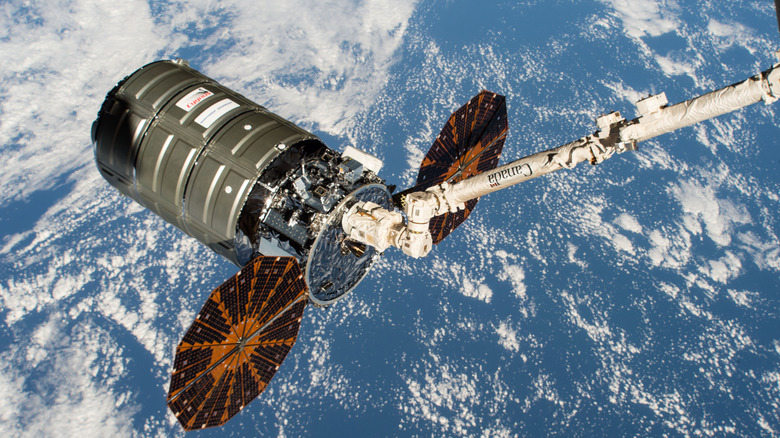Why NASA Deliberately Set Its Own Spacecraft On Fire
When it comes to space travel, there's one thing that people fear beyond all others: fire. Fires in space are incredibly dangerous, as the lack of oxygen in space means that spacecraft must carry oxygen with them in a pressurized environment. If a fire starts in such an environment, it becomes deadly extremely quickly.
But it's hard to know how to prevent and protect against fires in space because fire behaves differently in space than it does on Earth. That is not only because of the pressurized oxygen-rich environments on spacecraft, but also because of microgravity. With minimal gravity in space environments, fires burn differently than they would in a comparable environment on the ground.
So how do you learn to protect astronauts from an unpredictable threat? NASA's solution was a series of experiments called Spacecraft Fire Safety Experiments or Saffire, which made use of empty cargo vehicles departing from the International Space Station, with fires deliberately set inside them so the effects could be researched.
The first Saffire mission was completed in 2016, and the most recent, Saffire-VI, was just completed in February 2024. That marks the end of this important but slightly terrifying series of experiments, which NASA says has provided key insights into how fire behaves in space, including how it grows and spreads and what combinations of chemicals in the environment can cause it to burn faster or longer.
Learning from fire
The recent Saffire-VI experiment was launched to the International Space Station in August 2023, traveling with other cargo on a Northrop Grumman Cygnus spacecraft. The spacecraft and the experiment remained at the ISS until January 2024, when the spacecraft was ready to undock. These cargo spacecraft are not designed for re-entry, so they don't come back to Earth once their job is done. Instead, they burn up in Earth's atmosphere.
Sometimes the ISS crew will fill these cargo spacecraft with trash they are getting rid of, but in this case, NASA decided to make use of the spacecraft one more time by running a Saffire experiment on it. They wait until the cargo spacecraft is safely away from the ISS, then remotely set fire to samples inside. The research was designed to learn more about fire to help create better spacesuits and spacecraft to make them safer.
"How big a fire does it take for things to get bad for a crew?" said principal investigator David Urban on the NASA blog. "This kind of work is done for every other inhabited structure here on Earth – buildings, planes, trains, automobiles, mines, submarines, ships – but we hadn't done this research for spacecraft until Saffire."
The previous Saffire experiments involved burning samples such as a composite of cotton and fiberglass, or the kind of acrylic glass which is used for spacecraft windows. But Saffire-VI was different because it occurred in a higher oxygen and lower pressure environment, simulating what a crewed spacecraft is like.
How Saffire works
Saffire-VI was designed not only to see how fire changes in space but also to test whether fire could be accurately detected (as early warning systems for fires would be extremely important for spacecraft crews) and even how crews could clean up after a fire had occurred.
To test how samples reacted to the fire, they were placed inside a box that had a bead-lined wire inside that could be used to start the fire remotely. The box also had cameras inside so that the results of the test could be monitored.
Fires need oxygen, so the box wasn't airtight. Instead, air moved through it to feed the fire. "The Saffire flow unit is a wind tunnel. We're pushing air through it," explained experiment leader Gary Ruff, project manager at NASA's Glenn Research Center. "Once test conditions are set, we run an electrical current through a thin wire, and the materials ignite."
In total, the researchers performed 19 runs of the Saffire-VI experiment, with data not only from the cameras but also from sensors outside the box which measured things like the amount of heat generated.
"You've got a heat release rate and a rate of release of combustion products," Ruff said. "You can take those as model input and predict what will happen in a vehicle."
The series of experiments is now at an end, but they have helped to demonstrate the behavior of fire and how to protect astronauts against it in the future.
